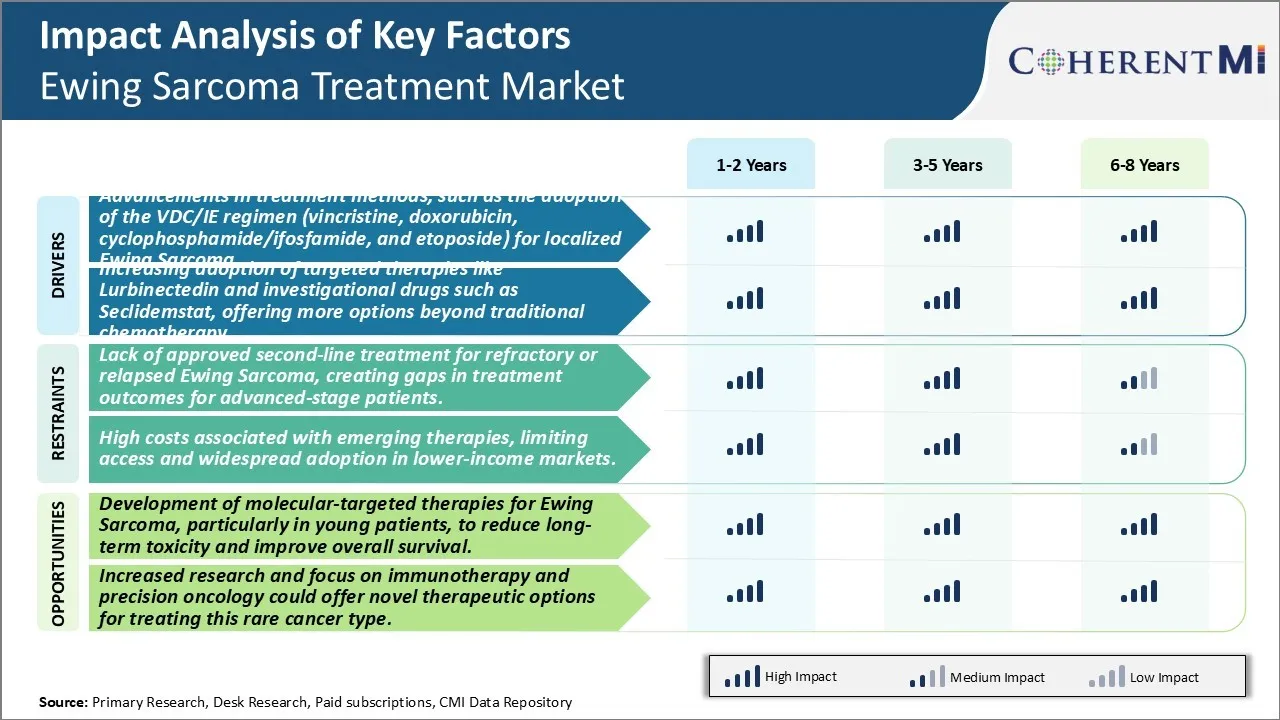Ewing Sarcoma Treatment Market Trends
Market Driver - Advancements in Treatment Methods, Such as the Adoption of VDC/IE Regimen (Vincristine, Doxorubicin, Cyclophosphamide/Ifosfamide, And Etoposide) For Localized Ewing Sarcoma.
The management of Ewing sarcoma has evolved over the years with the adoption of multimodal treatment regimens that combine chemotherapy with surgery and/or radiation therapy. Traditionally, first-line therapy comprised of vincristine, doxorubicin, cyclophosphamide, and occasionally ifosfamide and etoposide (VDC/IE). While offering reasonable survival benefits, this conventional chemotherapy was often associated with significant treatment-related toxicities.
In recent times, the VDC/IE regimen has gained renewed interest owing to modestly improved progression-free and overall survival demonstrated by European and American clinical studies. Particularly, a European study reported a 5-year event-free and overall survival of 65% and 70% respectively with the VDC/IE regimen in patients with localized Ewing sarcoma. The reduced dose and duration of ifosfamide and etoposide in this regimen is thought to offer a relatively safer toxicity profile. Several medical centers have since adopted this modified VDC/IE protocol as the standard first-line therapy for patients with non-metastatic Ewing sarcoma based on its effectiveness.
Market Driver - Increasing Adoption of Targeted Therapies Boosts Industry Developments.
While multimodal treatment approaches have enhanced outcomes over the years, treatment resistance and relapse remain major challenges in Ewing sarcoma management. This has prompted continued research into novel targeted agents that act through non-classical mechanisms. In recent years, a few targeted therapies have emerged that offer patients more lines of treatment beyond traditional chemotherapy.
Notably, the antitumor antibiotic lurbinectedin has demonstrated promising anti-tumor activity against various types ofsoft tissue sarcoma in clinical trials. Based on a pivotal phase II study, lurbinectedin has received regulatory approvals in several countries for treating relapsed Ewing sarcoma. Meanwhile, early clinical studies of investigational drugs like seclidemstat, a novel reversible LSD1 inhibitor, have shown signals of anti-tumor response in refractory Ewing sarcoma. Such targeted agents that block specific molecular pathways driving tumor growth present new hope for patients with advanced or relapsed disease. Several ongoing combination studies aim to evaluate safety and efficacy of incorporating these targeted drugs with standard chemotherapy backbones. Their increasing adoption could potentially improve long-term outcomes over time.

Market Challenge - Lack of Approved Second-Line Treatment For Refractory or Relapsed Ewing Sarcoma, Creating Gaps in Treatment Outcomes for Advanced-Stage Patients.
There is a significant unmet need for effective second-line treatment options for patients with Ewing sarcoma whose disease has become refractory or relapsed following first-line standard of care chemotherapy regimens. Current treatment protocols typically involve intense multi-agent chemotherapy consisting of vincristine, doxorubicin, cyclophosphamide, ifosfamide, and etoposide. However, a sizable portion of patients will experience disease progression either during or following first-line treatment. For these patients, there are no approved or standardized second-line therapies available. Physicians are left with limited treatment options that consist mainly of pragmatic clinical trials evaluating new agents or combinations. This lack of an established standard of care protocol for relapsed/refractory disease leads to worse treatment outcomes and lower survival rates compared to patients able to achieve remission from front-line treatment. Developing an FDA-approved second-line treatment could help address this unmet need and reduce treatment gaps, improving outcomes for advanced-stage Ewing sarcoma patients.
Market Opportunity: Development of Molecular-Targeted Therapies for Ewing Sarcoma, Particularly in Young Patients, to Reduce Long-Term Toxicity and Improve Overall Survival.
There is significant potential to develop novel molecular-targeted therapies for Ewing sarcoma that improve upon conventional chemotherapy regimens. As the majority of Ewing sarcoma patients are children and young adults, reducing long-term treatment-related toxicities is paramount. Targeted therapies that inhibit specific molecular pathways driving cancer growth hold promise to deliver strong anti-tumor activity with more favorable safety profiles compared to traditional cytotoxic chemotherapies. Recent research has provided insights into recurring genetic mutations and dysregulated pathways in Ewing sarcoma, identifying new targets for drug development. Agents targeting programs like FGF/FGFR, IGF1/IGF1R, and PDGF/PDGFR pathways show early signs of clinical benefit. Continued investigation of targeted agents, especially in biomarkers-selected patient subgroups, could lead to options that are both more effective and better tolerated long-term than current standard of care regimens. This may help maximize quality of life outcomes which is especially important in younger patients.